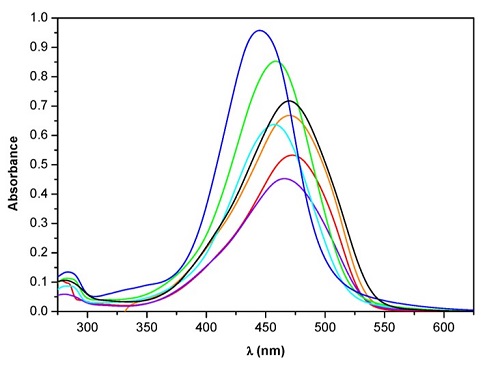Hydrodabcyl
Hydrodabcyl is a new dark fluorescence quencher, an alternative to dabcyl, useful for many biomolecular analytical applications (studying biomolecular processes).
Highlights:
- Ideal solubility-stability-absorption profile
- Excellent solubility in aqueous media
- Useful for high-throughput enzymatic tests
Dark fluorescence quenchers are nonfluorescent dyes that can modulate the fluorescence signal of an appropriate fluorophore donor in a distance-dependent manner.[2]The popular dark quencher dabcyl is widely used for developing FRET-based dual-labeled protease substrates and nucleic acid probes, but its hydrophobicity and resulting poor water solubility can cause problems in bioassays with aqueous solutions.
Hydrodabcyl is a polar and water soluble alternative retaining spectral properties similar to those of dabcyl. This feature enables researchers to keep all assay settings similar to those of dabcyl-containing probes. The water solubility is greatly improved compared to dabcyl without adding electric charges or sterically demanding polar groups. Hydrodabcyl was used to synthesize different protease substrates [2]: improved enzyme performance was demonstrated, especially in the case of small substrates in which the hydrophobicity of the dyes cannot be compensated by the hydrophilicity of the substrate.
From the laboratory of Elisa Bombarda, PhD, University of Bayreuth
Hydrodabcyl is a new dark fluorescence quencher, an alternative to dabcyl, useful for many biomolecular analytical applications (studying biomolecular processes).
Highlights:
- Ideal solubility-stability-absorption profile
- Excellent solubility in aqueous media
- Useful for high-throughput enzymatic tests
Dark fluorescence quenchers are nonfluorescent dyes that can modulate the fluorescence signal of an appropriate fluorophore donor in a distance-dependent manner.[2]The popular dark quencher dabcyl is widely used for developing FRET-based dual-labeled protease substrates and nucleic acid probes, but its hydrophobicity and resulting poor water solubility can cause problems in bioassays with aqueous solutions.
Hydrodabcyl is a polar and water soluble alternative retaining spectral properties similar to those of dabcyl. This feature enables researchers to keep all assay settings similar to those of dabcyl-containing probes. The water solubility is greatly improved compared to dabcyl without adding electric charges or sterically demanding polar groups. Hydrodabcyl was used to synthesize different protease substrates [2]: improved enzyme performance was demonstrated, especially in the case of small substrates in which the hydrophobicity of the dyes cannot be compensated by the hydrophilicity of the substrate.
From the laboratory of Elisa Bombarda, PhD, University of Bayreuth
| Catalog Number | Product | DataSheet | Size | AVAILABILITY | Price | Qty |
|---|
| Product Type: | Small Molecule |
| Name: | Hydrodabcyl [4-(2',6'-dihydroxy-4'-dimethylaminophenylazo)-2-hydroxybenzoic acid] |
| CAS number: | CAS: 1934257-88-1 |
| Chemical Formula: | C15H15N3O5 |
| Molecular Weight: | 317.3 g/mol |
| Format: | Lyophilized powder in dark glass tubes (red solid) |
| Purity: | >95%, HPLC |
| Solubility: |
In DMSO at 20°C, at least 2.5×10-2 M; In 50 mM NaP buffer pH 8.0 at 20°C, at least 2.5×10-2 M; In deionized water (ultrasonic bath), at least 5.7×10-4 M |
| Abs Max (nm): |
Absorbance [1, 2, 3]: λMax = 445 nm, ε445 = 43000 M-1 cm-1, in 50 mM NaP buffer pH 8.0 at 20C; λMax = 470 nm, ε470 = 37000 M-1 cm-1, in DMSO at 20C |
| Platform: | Microplate reader [1] |
| Compatible Cells: | HT-29 (adherent colon carcinoma), EaHy.926 (endothelial hybrid cells), CHF (chicken heart fibroblast). As labelled derivative, it was tested in oocytes of Xenopus laevis [1]. |
| Detection Method: | UV-Vis absorption, fluorescence |
| Comments: |
Suggested amount per experiment: 100mg. M.p. 253C; It is stable in acidic/neutral aqueous solutions. In basic aqueous solution, anoxic conditions are recommended when stability for more than one day is desired. Tip: store in non-trasparent tightly closed flasks and sealed with Para film. |
| Storage: |
As a solid or as a stock solution in DMSO, it can be stored in a dark and dry place at room temperature for at least 1 year. Store away from oxidizing agents. |
| Shipped: | Ambient temperature, protect from light |
Hydrodabcyl Spectral Characterization

Figure 1. (left) Comparison of molar absorbances of dabcyl (1) in DMSO (red curve, λMax = 451 nm, ε451 = 32000 M−1 cm−1), hydrodabcyl (2) in DMSO (black curve, λMax = 470 nm, ε470 = 37000 M−1 cm−1) and 2 in buffered aqueous solution pH 8.0 (blue curve λMax = 445 nm, ε445 = 43000 M−1 cm−1); all at 20 °C. Figure 2. (right) Comparison of the absorbance of hydrodabcyl 2x10-5 M in different solvents at T=20°C. Buffer pH=8.0 (blue) λmax=445 nm, methanol (dashed grey) λmax=458 nm, ethanol (dashed black) λmax=460 nm.

Figure 3. Comparison of the absorbance of hydrodabcyl 2x10-5 M in different solvents at T=20°C. Buffer pH=8.0 (blue) λmax=445 nm, methanol (light blue) λmax=458 nm, ethanol (green) λmax=460 nm, acetonitrile (violet) λmax=465 nm, tetrahydrofuran (red) λmax=467 nm, dimethylsulfoxide (black) λmax=470 nm, acetone (orange) λmax=471 nm.
Practical tip: prepare stock solution in DMSO and dissolve freshly for the experiments in aqueous solutions.
- Bombarda E., Kempf O., Kempf K., Ullmann G.M., Schobert R. Patent: Hydrodabcyl. International patent WO 2016/083611 A1, issued 02.06.2016; (US Patent 25.05.2017; EU Patent 24.07.2018).
- Kempf O., Kempf K., Schobert R., Bombarda* E. Hydrodabcyl: A Superior Hydrophilic Alternative to the Dark Fluorescence Quencher Dabcyl. Anal. Chem., 2017, 89, 11893-11897. DOI: 10.1021/acs.analchem.7b03488.
- Kempf O., Ullmann G.M., Schobert R., Kempf K.*, Bombarda E.*. Chemoselective attachment of the water-soluble dark quencher hydrodabcyl to amino groups in peptides and preservation of its spectroscopic properties over a wide pH range. ACS Omega, 2021, 6, 32896-32903.21. DOI:10.1021/acsomega.1c04891.
If you publish research with this product, please let us know so we can cite your paper.


